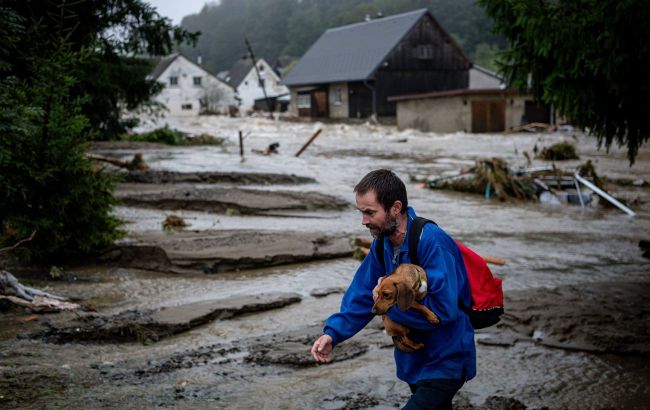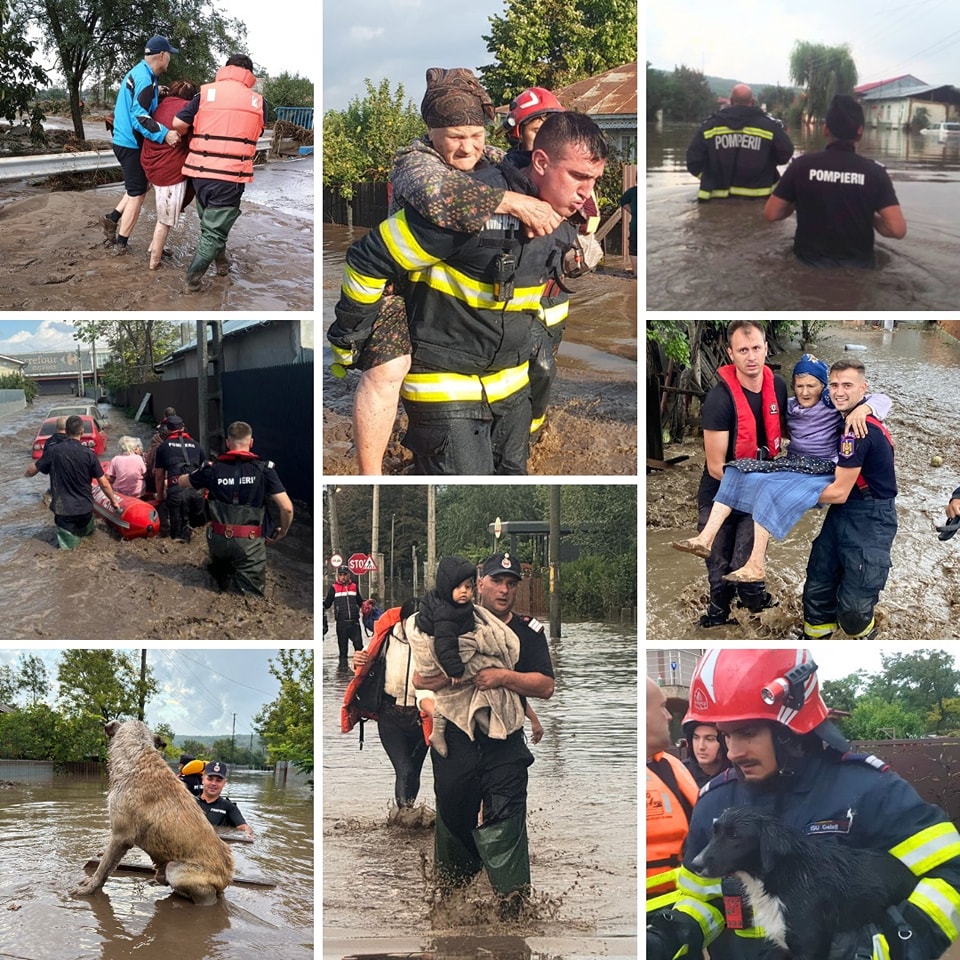Villages under water and first victims: Consequences of powerful floods in Europe
 Photo: Storm Boris sweeps through Europe (Getty Images)
Photo: Storm Boris sweeps through Europe (Getty Images)
This weekend, the storm Boris hit Central and Eastern Europe, causing heavy rains and flooding. Austria, Czechia, Poland, Romania, Slovakia, and Hungary suffered the worst damage from the storm. Some villages were submerged, at least 8 people died, and they are still missing.
RBC-Ukraine complies with details and consequences of the powerful floods in Europe in the report below.
Contents
- Austria
- Poland
- Czechia
- Romania
- Moldova
- Slovakia
- Hungary
- Germany
- Ukraine offered to help
- Why Storm Boris caused such devastation in Europe
Austria
The federal state of Lower Austria suffered the most from the storm. One firefighter died during the operation to rescue citizens from the flood.
More than 25,000 emergency workers were involved in the relief effort, supported by about 2,400 soldiers. The military used a Black Hawk helicopter to transport large bags of sand and gravel to strengthen weakened dams.
The situation was particularly critical on the Kamp River, where there were significant floods. In addition, a dam burst in the city of St. Pölten (Lower Austria). The entire territory of the settlement was flooded. The community has set up emergency shelters.
Johanna Mikl-Leitner, the Prime Minister of Lower Austria, said that it was an exceptional situation they had never faced before.
The situation in the capital Vienna is also tense. The area surrounding Vienna has been declared a disaster zone, with local authorities talking about an unprecedented extreme situation.
The Vienna River, which normally flows calmly, has turned into a swift torrent and flooded bike paths and streets. The tracks of some subway routes are also flooded, and two subway lines have been partially suspended. At least one highway is flooded. Train traffic in Austria is also severely disrupted.
In turn, the Prime Minister of Lower Austria expressed hope that the decrease in precipitation on Monday evening should bring a little respite.
Austrian Chancellor Karl Nehammer also commented on the situation, holding a meeting of the crisis headquarters over the weekend.
He wrote that the situation remained serious, particularly in Lower Austria, where it was extremely difficult. Thousands of firefighters and other emergency services were battling the floods, and disaster relief forces were working in a very coordinated manner across all states.
Poland
The situation in Poland is also dramatic. Prime Minister Donald Tusk, who was traveling to the flooded areas in the southwest, confirmed the death of one person and declared a state of natural disaster.
Speaking from the town of Klodzko, one of the hardest hit areas, Tusk said that 1,600 people in the area had been evacuated. He said a total of 17,000 people in the area are without power, and part of the Starlink satellite connections are being used to maintain cell phone signals and internet connections. In turn, the Mayor of Klodzko has already said that his city has lost the battle with the floods and the situation has become critical.
In the southwest of the country, floods on the Biala River broke through dams and fortifications in the towns of Glukholazy and Ladek-Zdroj. A helicopter was sent to Wroclaw to assist in rescue efforts.
Thousands of people had to be moved to safety, and many residents had to be evacuated from their rooftops. The authorities called in the army to help. Train traffic between Poland and Czechia was suspended. The Polish-Czech border crossing point Golkowice was closed on Saturday.
The Institute of Meteorology and Water Management reported that a dam broke in the Polish city of Wodzislaw Slaski. The flow of water destroyed at least one house. A bridge collapsed in the same village.
The Polish Defense Ministry stated that the military supporting the local population had been cut off from the land route back
In Glukholazy, a town in the southwest, authorities said the local river had burst its banks and was flooding the town.
At the same time, in Krakow, Poland's second-largest city, residents were offered sandbags to protect them from flooding.
Czechia
Czechia received the most precipitation, with some regions receiving three months' worth of rainfall in just three days. Several people are reported missing. Evacuations from flooded settlements continue.
The worst situation is in two northeastern regions. Houses in the Czech town of Jesenik are flooded. The town is completely cut off, as roads and railroad tracks are underwater, and the water is demolishing houses.
Flooding in Czechia has led to evacuations, in particular in the city of Opava, where up to 10,000 people out of a population of approximately 56,000 were asked to move to higher ground. At the same time, a total of 260,000 households across the country were left without electricity. Flood barriers have been raised in the capital, Prague.
Opava Mayor Tomáš Navrátil said that the situation was worse than during the last devastating flood in 1997, known as the "flood of the century."
For his part, Prime Minister Petr Fiala said the worst was not over yet and called for a focus on saving lives. On Monday, his government will meet to assess the damage.
Czech President Petr Pavel was more optimistic, saying that it was obvious that they had learned a lesson from the previous crisis.
Romania
The number of flood victims in Romania has risen to six. Thus, in the Galati region in the southeast of the country, four bodies were found on Saturday, and two more deaths were reported on Sunday. The town of Lipova, in the west, is closed from all sides and the next wave of flooding is still expected.
In Galati, more than 5,000 households in 12 towns have been affected. In some places, the water has risen to a level of 1.7 meters. Emergency workers are trying to rescue people by boat, and a helicopter has been involved in the search operation.
 Photo: the aftermath of the floods in Romania (facebook.com/igsu.situatiideurgenta)
Photo: the aftermath of the floods in Romania (facebook.com/igsu.situatiideurgenta)
The bad weather in Galati County also led to contamination of the county's wells. Romanian Minister of Health Alexandru Rafila explained to Digi24 that there is a risk of hepatitis A infection.
The Minister added that water from wells needed to be disinfected and tested by health authorities before being recommended for consumption. He advised that it was better to use bottled water or water supplied by the authorities and emphasized the importance of storing this water in hygienic conditions after being received to prevent contamination.
Meanwhile, Romania's Environment Minister Mircea Fechet told the Associated Press that in some heavily flooded areas, more than 160 liters of rain per square meter fell. This, he said, is a rare occurrence.
Moldova
In Moldova, the Byk River overflowed its banks, halting transportation and flooding the Chisinau Opera and Ballet Theater. The authorities declared yellow and orange levels of danger.
The General Inspectorate of Police of Moldova reported flooding of roads in Chisinau, Straseni, as well as in Cantemir and Leova districts. 13 settlements were left without electricity.
The Chisinau City Hall warned over the weekend that several basements of private houses and apartment buildings had already been flooded, rivers and some lakes had overflowed, and several parks were submerged. They urged people not to go out on the streets.
It is reported that rescuers have been called out more than a hundred times to pump out water in the central and southern regions of Moldova, as well as to remove fallen trees.
Slovakia
The Slovak capital Bratislava also declared a state of emergency on Saturday.
The water level continues to rise on the Slovak section of the Danube, expected to peak on Tuesday, and could reach as high as 9 meters, according to the Bratislava Új Szó.
According to the news agency, driving in the region is dangerous due to the extreme flooding, so several high schools in Bratislava have announced a break in work. It is still raining in the Slovak capital.
Hungary
After midnight, the flood alert level was raised in Budapest. According to Budapest Mayor Gergely Karacsony, the Hungarian capital is facing the biggest flood of the decade. The lower embankments of the city will be closed from 8 p.m.
Starting Tuesday, only vehicles involved in defense will be able to enter Margit Island on the Danube in Budapest, and pedestrian traffic will be restricted.
According to the Hungarian Department of Water Management, a record amount of water is flowing to the river island of Szigetkos.
On Monday morning, a flood defense task force headed by Prime Minister Viktor Orbán met. As a result, he named three dangerous places: the island of Szigetkoz, a bend in the Danube, and the city of Budapest.
Germany
In Germany, the situation remains relatively calm. In Bavaria, some streets were flooded, and in some places, water-filled basements. Upper Bavaria, Lower Bavaria, and the Upper Palatinate are currently the most affected.
The water level is also rising in eastern Germany, although the situation there is less critical. It is expected that on Monday, the Elbe River in Dresden will reach alert level 3 (6 meters). On Sunday evening, an alert 2 was declared thereafter the water level, according to the city, rose to 5.01 meters (as of 6 p.m.).
For comparison, the normal water level in the Elbe at the Dresden level is about 2 meters, and during the flood of the century in 2002, it reached 9.40 meters at its peak.
Ukraine offered to help
The Ukrainian side, in turn, offered European countries to send Security Service of Ukraine units to help flood victims. Foreign Minister Andrii Sybiha noted that Kyiv stands in solidarity with its neighbors who are suffering from the devastating floods.
“We offered Czechia, Hungary, Moldova, Poland, Romania, Slovakia to send our State Emergency Service’s units to assist in mitigating the disaster,” the Minister writes on X.
Meanwhile, this morning Ukrainian Railways announced changes in train traffic due to flooding in Central Europe.
Why Storm Boris caused such destruction in Europe
As we wrote, the storm Boris brought a huge amount of precipitation to Central and Eastern Europe. According to forecasts, the rains will continue at least until the end of Monday. The storm was so destructive for two reasons. First, it brings in colder air from the north, which mixes with moisture coming from the unusually warm waters of the Mediterranean and Black Seas.
Secondly, a low-pressure area is moving very slowly over the same areas, and the storm was sandwiched between high-pressure areas to the west and east. The Czech Ministry of Environmental Protection said that storms like Boris occur once every 50 years.
Following the extreme flooding in 2021 in Europe, the World Weather Prediction Network concluded that the likelihood and intensity of floods of this type in Europe are increasing due to rapid climate warming.
Sources: Tagesschau, The Washington Post, BBC, AP News, Telex, and data from local media.

